Bought By: 9310
Rating: 4.1
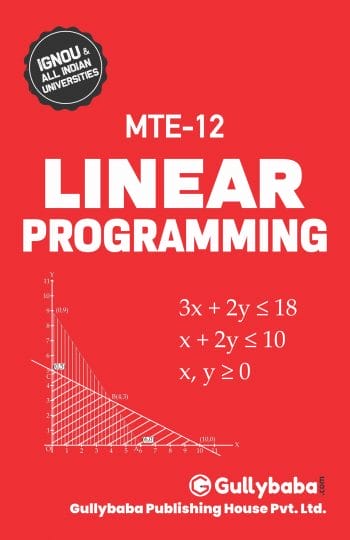
Get Good Marks in your B.Sc. Mathematics Programme in the Term-End Exams even if you are busy in your job or profession.
We've sold over 64,274,544 Help Books and Delivered 81,109,307 Assignments Since 2002.
As our customers will tell you...yes, it really result-oriented.
 3. a) A marketing manager has 5 salespersons and 5 sales districts. Considering the capabilities of the salespersons and the nature of the districts, the marketing manager estimates the sales per month (in thousand ₹) for each salesperson in each distinct as follows:
3. a) A marketing manager has 5 salespersons and 5 sales districts. Considering the capabilities of the salespersons and the nature of the districts, the marketing manager estimates the sales per month (in thousand ₹) for each salesperson in each distinct as follows:
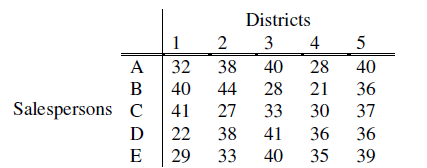 Find the assignment of sales persons to districts that will result in maximum sales.
b) Find the maximum and minimax values of the following matrix game.
Find the assignment of sales persons to districts that will result in maximum sales.
b) Find the maximum and minimax values of the following matrix game.
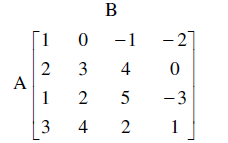 Does the matrix have a saddle point. Justify your answer.
c) The following table is obtained in the intermediate stage while solving an LPP by the simplex method.
Does the matrix have a saddle point. Justify your answer.
c) The following table is obtained in the intermediate stage while solving an LPP by the simplex method.
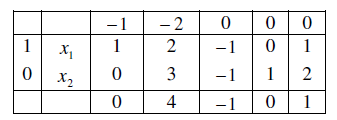 Discuss whether an optimal solution will exist or not.
4. a) Solve by simplex method the following linear programming problem:
Discuss whether an optimal solution will exist or not.
4. a) Solve by simplex method the following linear programming problem:
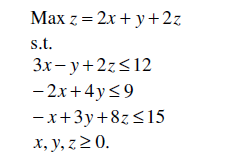 b) Show that the set of vectors
b) Show that the set of vectors
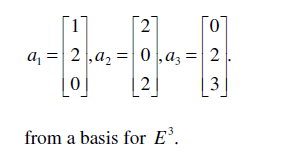 5. a) Use the principle of dominance to reduce the size of the following game. Hence solve the game.
5. a) Use the principle of dominance to reduce the size of the following game. Hence solve the game.
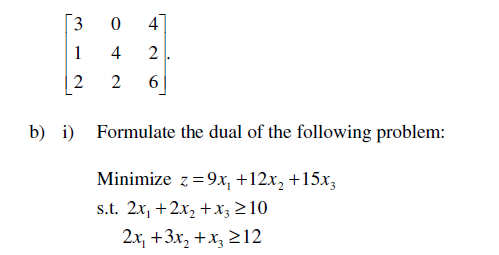
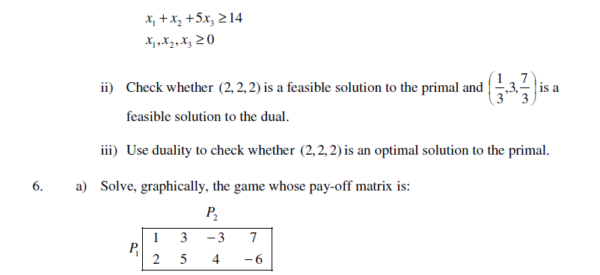 b) Find an initial basic feasible solution for the following transportation problem using matrix-minima method. Also find the transportation cost.
b) Find an initial basic feasible solution for the following transportation problem using matrix-minima method. Also find the transportation cost.
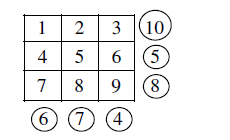 7. a) Using the initial basic feasible solution for the transportation problem given below, find and optimal solution for the problem.
7. a) Using the initial basic feasible solution for the transportation problem given below, find and optimal solution for the problem.
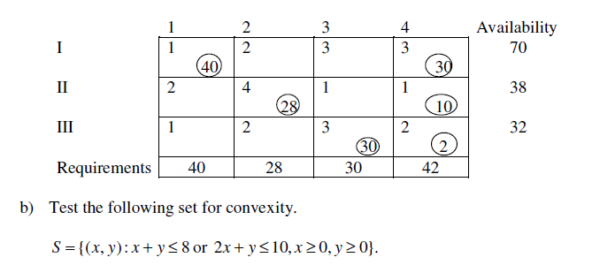
 b) Without sketching the region, check whether P(0,0) is in the convex hull of the points A(−1,−1),B(1,0) and C(0,1) . If it is in the region, write P as convex combination of A,B and C.
9. a) A businessman has to get 5 cabinets, 12 desks and 18 shelves cleaned. He has two part-time employees, Anjali and Arnav. Anjali can clean 1 cabinet, 3 desks and 3 shelves in a day, while Arnav can clean 1 cabinet, 2 desks and 3 shelves in a day. Arnav is paid ₹22 per day and Anjali is paid ₹ 25 per day. Formulate the problem of finding the number of days for which Anjali and Arnav have to be employed to get the cleaning done with minimum cost as a linear programming problem.
b) For the following pay-off matrix, transform the zero-sum game into an equivalent linear programming problem:
b) Without sketching the region, check whether P(0,0) is in the convex hull of the points A(−1,−1),B(1,0) and C(0,1) . If it is in the region, write P as convex combination of A,B and C.
9. a) A businessman has to get 5 cabinets, 12 desks and 18 shelves cleaned. He has two part-time employees, Anjali and Arnav. Anjali can clean 1 cabinet, 3 desks and 3 shelves in a day, while Arnav can clean 1 cabinet, 2 desks and 3 shelves in a day. Arnav is paid ₹22 per day and Anjali is paid ₹ 25 per day. Formulate the problem of finding the number of days for which Anjali and Arnav have to be employed to get the cleaning done with minimum cost as a linear programming problem.
b) For the following pay-off matrix, transform the zero-sum game into an equivalent linear programming problem: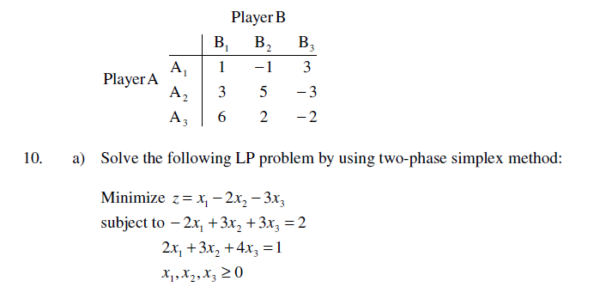
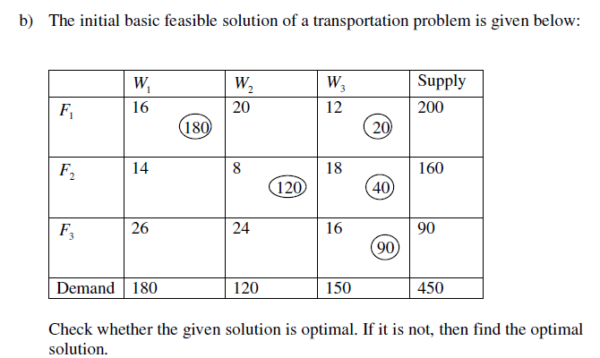
 b) Using the principle of dominance, reduce the size of the following game:
b) Using the principle of dominance, reduce the size of the following game:
 Hence solve the game.
3. a) Find all basic feasible solutions for the following set of equations:
Hence solve the game.
3. a) Find all basic feasible solutions for the following set of equations:
 b) Examine convexity of the following sets:
b) Examine convexity of the following sets:
 4. a) Solve the following linear programming problem by graphical method:
4. a) Solve the following linear programming problem by graphical method:
 b) Find the dual of the following LPP:
b) Find the dual of the following LPP:
 5. a) Find the initial basic feasible solution of the following transportation problem using matrix-minima method:
5. a) Find the initial basic feasible solution of the following transportation problem using matrix-minima method:
 Also, find the optimal solution.
b) Solve the following game graphically:
Also, find the optimal solution.
b) Solve the following game graphically:
 6. a) A firm manufactures two types of products, A and B, and sells them at a profit of ₹2 on type A and ₹ 3 on type B. Each product is processed on two machines M1 and M2. Type a requires one minute of processing time on M1 and two minutes on M2; type B requires one minute on M1 and one minute on M2. The machine M1 is available for not more than 6 hours 40 minutes while machine M2 is available for 10 hours during any working day.
Formulate the problem at LPP.
b) Solve the following assignment problem:
6. a) A firm manufactures two types of products, A and B, and sells them at a profit of ₹2 on type A and ₹ 3 on type B. Each product is processed on two machines M1 and M2. Type a requires one minute of processing time on M1 and two minutes on M2; type B requires one minute on M1 and one minute on M2. The machine M1 is available for not more than 6 hours 40 minutes while machine M2 is available for 10 hours during any working day.
Formulate the problem at LPP.
b) Solve the following assignment problem:
 7. a) The following table is obtained in the intermediate state while solving an LPP by simplex method:
7. a) The following table is obtained in the intermediate state while solving an LPP by simplex method:
 Check whether an optimal solution of the LPP will exist or not.
b) Write the LPP model of the following transportation problem:
Check whether an optimal solution of the LPP will exist or not.
b) Write the LPP model of the following transportation problem:
 c) Find the range of values of p and q which will render the entry (2, 2), a saddle point for the following game:
c) Find the range of values of p and q which will render the entry (2, 2), a saddle point for the following game:
 8. a) Test the convexity of the following sets:
8. a) Test the convexity of the following sets:
 b) Determine all the basic feasible solutions to the equations
b) Determine all the basic feasible solutions to the equations
 Identify the degenerate basic feasible solutions.
9. a) Let
Identify the degenerate basic feasible solutions.
9. a) Let  Compute AB, BC, AC, if they exists, otherwise, give reason for their non-existence.
b) Solve the following LPP:
Compute AB, BC, AC, if they exists, otherwise, give reason for their non-existence.
b) Solve the following LPP:
 c) Find the saddle point (if exists) in the following pay-off matrix:
c) Find the saddle point (if exists) in the following pay-off matrix:
 Also, find the value of the game.
10. a) Determine an initial basic feasible solution to the following transportation problem and hence find an optimal solution to the problem:
Also, find the value of the game.
10. a) Determine an initial basic feasible solution to the following transportation problem and hence find an optimal solution to the problem:
 b) Find all values of k for which the vectors
b) Find all values of k for which the vectors  are linearly independent.
are linearly independent.To attend IGNOU MTE-12 Term-End Examination, you must first submit your Assignments to the university and it is possible from the MTE-12 study material. You can solve all necessary Assignments using Help Books. This will help in gaining good marks.
All best wishes with our efforts that you do not meet any obstacle before attending examinations next year. You can pass the B.Sc. Mathematics Programme Annual Exams with a good grade using Books/Materials from any one place at home or anywhere else!
ALL THE BEST!!!
Team GullyBaba